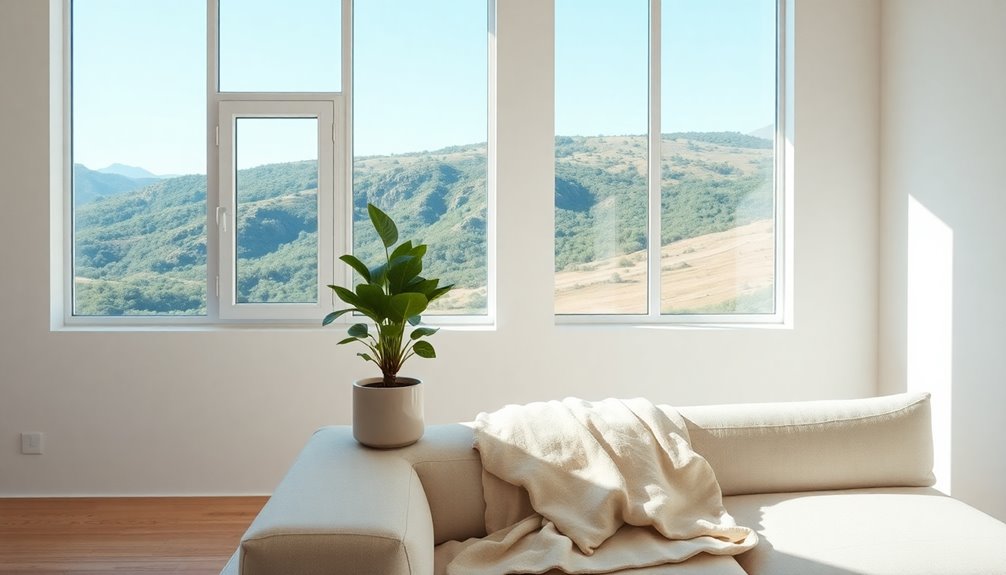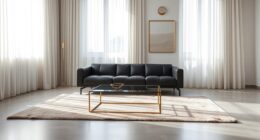Minimalism plays an essential role in sustainable design by prioritizing simplicity and functionality. By choosing multifunctional furniture and eco-friendly materials, you reduce clutter and your carbon footprint. Minimalist spaces often incorporate natural light and renewable energy, enhancing comfort while lowering energy consumption. This approach not only supports environmental responsibility but also promotes mindful living. If you're curious about real-world examples and how to apply these principles, you'll find plenty of inspiring insights ahead.
Key Takeaways
- Minimalism emphasizes simplicity, promoting the use of sustainable materials that reduce environmental impact and waste.
- Multifunctional furniture in minimalist design maximizes space efficiency, aligning with eco-friendly trends by minimizing resource consumption.
- Incorporating natural light and energy-efficient solutions in minimalist spaces enhances comfort while reducing reliance on artificial energy sources.
- A minimalist lifestyle encourages intentional consumption, leading to a smaller carbon footprint and support for eco-friendly practices.
- Real-world examples, like the Tiny House Movement, showcase how minimalist design can integrate renewable energy and sustainable living.
The Core Principles of Sustainable Design and Minimalism

When you explore sustainable design and minimalism, you'll find that both movements share a commitment to simplicity and environmental responsibility.
Sustainable materials play a significant role, emphasizing high-quality, durable options that lower the need for replacements and reduce waste.
Energy efficiency is another key principle; integrating natural light not only beautifies spaces but also aligns with minimalist design by minimizing reliance on artificial lighting.
Integrating natural light enhances beauty and reduces reliance on artificial lighting, embodying the essence of minimalist design.
This synergy promotes well-being and enhances functionality.
By focusing on multifunctional furniture and modular designs, you create a clutter-free environment, embodying the "less is more" philosophy.
Together, sustainable design and minimalism encourage intentional consumption, leading to a smaller carbon footprint and a more serene, eco-friendly living space. Additionally, adopting sustainable habits supports overall well-being and fosters a deeper connection to the environment.
Eco-Friendly Materials: The Backbone of Sustainable Spaces
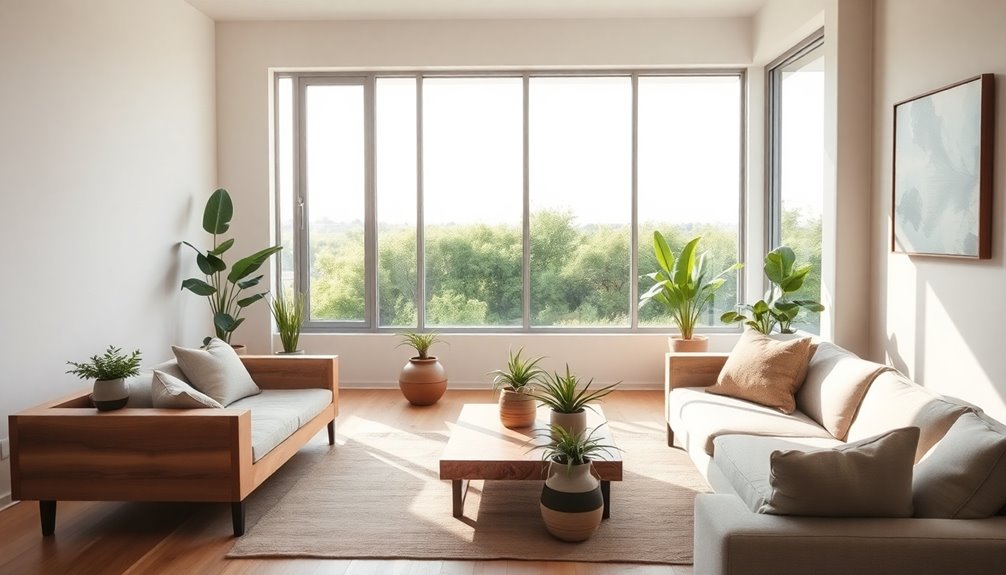
As you explore eco-friendly materials, you'll discover they form the cornerstone of sustainable spaces. Utilizing sustainable options like bamboo and cork reduces environmental impact, while recycled materials divert waste from landfills and offer a unique aesthetic. Non-toxic paints enhance indoor air quality, making your home healthier. Additionally, incorporating efficient wood stoves can further enhance the sustainability of your living space by providing eco-friendly heating options.
Here's a quick overview of essential eco-friendly materials:
| Material Type | Benefits |
|---|---|
| Reclaimed Wood | Sustainable flooring, minimal waste |
| Recycled Materials | Lowers resource demand, unique designs |
| Non-Toxic Paints | Improves indoor air quality |
| Eco-Friendly Textiles | Supports sustainable agriculture |
Incorporating these elements not only aligns with minimalism but also contributes to a healthier and more sustainable living environment.
Energy Efficiency: Enhancing Comfort While Reducing Consumption
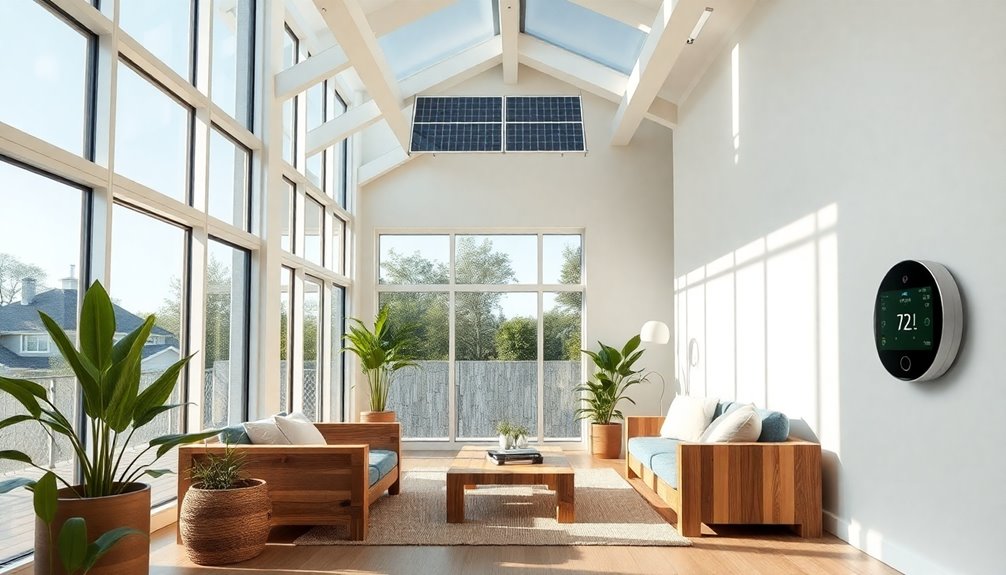
You can enhance your home's comfort and reduce energy consumption by embracing smart home technologies, natural lighting solutions, and efficient insulation techniques. These strategies not only lower your utility bills but also create a healthier living environment. Additionally, incorporating energy-efficient models can significantly reduce electricity costs while promoting sustainability.
Smart Home Technologies
Smart home technologies are revolutionizing how we manage energy consumption while enhancing comfort in our living spaces. By using smart thermostats, you can reduce energy consumption by up to 15%, adjusting heating and cooling based on your presence and preferences.
Energy-efficient smart lighting systems save about 75% more energy than traditional bulbs, contributing to sustainable living. Integrating smart appliances, like energy-efficient refrigerators, can cut energy use by 30%, promoting eco-friendly practices.
Additionally, systems that monitor real-time energy usage help you make informed decisions to minimize waste and reduce your carbon footprint. When combined with renewable energy solutions like solar panels, smart home technologies can optimize energy efficiency, allowing you to produce and manage your own energy effectively. Furthermore, solar charge controllers play a vital role in maximizing energy harvest from solar panels, enhancing the overall efficiency of your smart home system.
Natural Lighting Solutions
Natural lighting solutions play an essential role in enhancing energy efficiency while creating comfortable living spaces. By maximizing natural light, you not only reduce your reliance on artificial lighting but also improve your well-being.
Here are three key benefits of embracing a minimalist approach to natural lighting:
- Decrease energy consumption: You can cut down lighting needs by up to 75% during daylight hours.
- Enhance comfort: Exposure to natural light boosts productivity and mental health.
- Lower environmental impact: Well-lit homes achieve better energy performance ratings, reducing utility bills and waste.
Integrating smart home systems, like automated shades, optimizes natural light usage, contributing to eco-friendly trends while ensuring you enjoy a bright, inviting space. Additionally, maintaining indoor air quality through efficient air purifiers can further enhance your living environment.
Efficient Insulation Techniques
While many homeowners focus on aesthetics when designing their spaces, efficient insulation techniques are essential for achieving energy efficiency and comfort.
By using materials like spray foam and cellulose, you can considerably reduce energy consumption for heating and cooling by up to 50%. This not only lowers your utility bills but also enhances indoor comfort by maintaining consistent temperatures year-round.
High-performance options, such as rigid foam boards and mineral wool, provide excellent thermal resistance, helping to reduce energy loss through walls, attics, and floors.
Incorporating these eco-friendly trends in your home supports sustainable design, decreases fossil fuel consumption, and minimizes greenhouse gas emissions—contributing to green living and a healthier environment for everyone. Additionally, integrating energy-efficient water systems can further enhance the sustainability of your home by reducing overall water consumption.
The Influence of Minimalism on Modern Interior Design

Minimalism has greatly shaped modern interior design, creating spaces that prioritize simplicity and functionality. By embracing minimalist aesthetics, you can foster a calming atmosphere that enhances your living experience.
Minimalism transforms modern interiors, emphasizing simplicity and functionality for a serene and enhanced living experience.
Consider these elements that evoke mindful living:
- Sustainable materials like bamboo and reclaimed wood reduce your environmental footprint.
- Multifunctional furniture, such as sofa beds and modular shelving, promotes efficient space use.
- Neutral colors and natural light create serene environments that elevate your mood.
Incorporating natural elements into your decor can enhance tranquility and connect you to the environment.
These interior design trends not only reflect a commitment to sustainable design but also lead you toward intentional purchasing.
Adopting minimalism can transform your home into a stylish sanctuary while supporting eco-friendly practices.
The Benefits of Embracing a Minimalist Lifestyle

Embracing a minimalist lifestyle brings significant advantages, starting with a reduced environmental footprint.
You'll find that focusing on quality over quantity not only enhances your mental clarity but also leads to cost-effective living choices.
Simplifying your life can create a more organized space while benefiting both you and the planet. Additionally, adopting minimalism can encourage solar energy solutions that empower individuals to harness renewable energy for their homes.
Reduced Environmental Footprint
Adopting a minimalist lifestyle not only simplifies your life but also considerably reduces your environmental footprint.
By focusing on intentional living, you can make significant strides toward sustainable design and mindful consumption. Here are three impactful benefits of minimalism:
- Achieve up to a 23% smaller carbon footprint, contributing to a cleaner planet.
- Prioritize quality over quantity, leading to longer-lasting items that reduce waste disposal and manufacturing emissions.
- Foster sustainable habits that minimize your ecological footprint, helping manage resource depletion.
Embracing a less-is-more attitude empowers you to make choices that lower waste generation and promote a healthier environment. Additionally, effective ventilation can enhance indoor air quality, supporting both minimalism and sustainability in your home design.
Enhanced Mental Clarity
When you simplify your surroundings, you often find that mental clarity follows suit. Embracing minimalism creates a clutter-free environment that reduces visual distractions, allowing your mind to focus and find tranquility.
This intentional living fosters mindfulness, helping you prioritize meaningful experiences over material possessions, which leads to greater satisfaction. Studies show that individuals who adopt minimalist principles report lower stress levels and improved well-being.
By using natural materials and maximizing natural light, you enhance your living space, further reducing anxiety. A clutter-free environment not only enhances cognitive function but also improves decision-making and productivity.
Ultimately, embracing a minimalist lifestyle aligns with eco-friendly trends and promotes a clearer, more serene mind. Additionally, reducing stress levels through decluttering can significantly enhance overall emotional well-being.
Cost-Effective Living Choices
Living a minimalist lifestyle not only streamlines your space but also considerably cuts down on expenses.
By adopting minimalism, you embrace sustainable design that prioritizes cost-effective living choices.
Here are three benefits you can enjoy:
- Durable Products: Investing in quality items means you replace them less often, reducing waste.
- Multifunctional Items: Choose convertible furniture to save money and space while minimizing resource consumption.
- Mindful Decluttering: Regularly decluttering your home encourages donations, fostering eco-friendly trends and reducing landfill overflow.
Real-World Examples of Minimalism in Sustainable Design
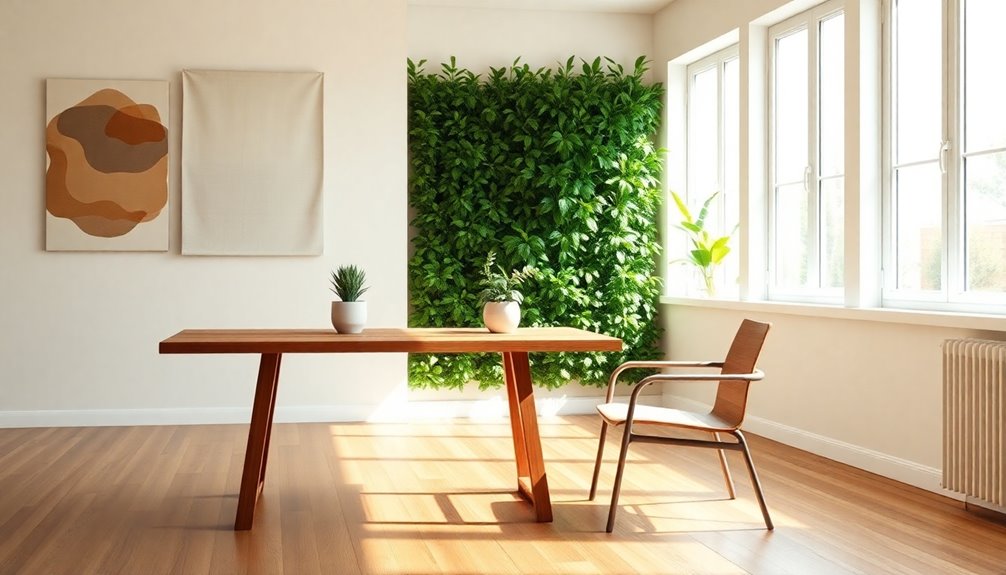
Minimalism in sustainable design is more than just a trend; it's a movement transforming how we think about our environment and resources.
Take IKEA's "Sustainable Living" initiative, which promotes minimalist furniture crafted from renewable and recycled materials, encouraging eco-friendly lifestyles.
The MoMA PS1's "The Living" installation showcases how minimalistic structures using mycelium exemplify eco-friendly architecture.
In fashion, brands like Everlane focus on quality over quantity, creating sustainable garments that align with the capsule wardrobe concept.
The Tiny House Movement embodies minimalism in sustainable living, with compact homes that maximize space and often integrate renewable energy.
Finally, the Green Building trend emphasizes minimalist spaces designed for energy efficiency, utilizing reclaimed wood and bamboo to reduce carbon footprints.
Frequently Asked Questions
How Is Minimalist Design Environmentally Friendly?
Minimalist design's environmentally friendly because it focuses on reducing excess and prioritizing essential items.
By choosing high-quality, durable materials, you're less likely to contribute to waste from frequent replacements.
You'll find that multifunctional furniture saves space and decreases the need for multiple purchases, cutting down resource consumption.
Utilizing natural light instead of artificial lighting not only brightens your space but also lowers energy use, making your home more sustainable overall.
How Does Minimalism Help the Environment?
Imagine you decide to declutter your home, keeping only essential items. By doing this, you're reducing your carbon footprint since minimalism encourages less consumption.
When you choose quality over quantity, like investing in a sturdy, multifunctional table instead of multiple pieces, you cut down on waste and resource usage.
Plus, you might start upcycling old furniture, which extends its lifecycle and keeps it out of landfills, making a positive impact on the environment.
How Does Sustainable Design Help the Environment?
Sustainable design helps the environment by prioritizing eco-friendly materials and energy-efficient systems.
You'll notice it reduces resource depletion and lowers greenhouse gas emissions.
When you choose spaces with natural light and non-toxic finishes, you create healthier indoor environments.
Plus, using recycled materials cuts down on waste and the demand for new resources.
What Is Sustainable Minimalism?
Imagine walking into a space that feels open, inviting, and effortlessly calm.
That's the essence of sustainable minimalism. It's about embracing simplicity while prioritizing eco-conscious choices. You focus on quality over quantity, investing in durable items that last.
With sustainable materials like bamboo and reclaimed wood, you're not just decluttering; you're making a statement.
This approach fosters a harmonious relationship with your environment, allowing you to live intentionally and sustainably.
Conclusion
As you embrace sustainable design, imagine stepping into a space where every item serves a purpose, and the air feels lighter. Picture eco-friendly materials surrounding you, whispering stories of the earth. With energy-efficient solutions, your comfort is enhanced while your impact dwindles. Can you feel the pull of minimalism guiding your choices? By adopting this lifestyle, you're not just transforming your home; you're contributing to a brighter future. Will you take the leap into this serene, sustainable world?
